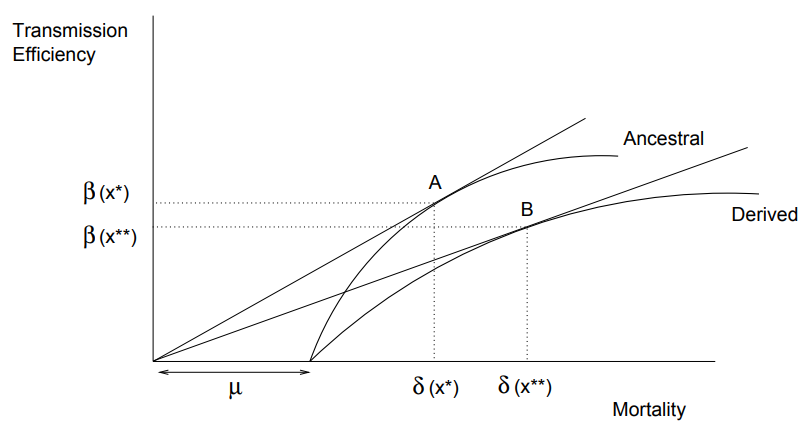The answer seems to be "not much". I did find one paper that proposed MVT for viruses but instead of transmission efficiency in abstract terms they used/proposed lysis time as the parameter that might get optimized for/by phages. And as dependent variable they proposed not mortality but host density.
The problem indeed seems to be that before one even bothers to consider such a (MVT) model, the assumption[s] that that parameter gets optimized need to pass the "smell test".
A fundamental issue is whether the phenotype at the
center of an optimality model has sufficient genetic
variation that is sufficiently unconstrained to evolve in a
manner consistent with the model. There might be a lack
of genetic variation in the phenotype per se. Alternatively,
there might be genetic variation for the phenotype, but
such variation lies in a ‘higher dimensional space’ than is
assumed in the optimality model [32,33]. This means that
selection acting on traits outside of the optimality model
can drive phenotype evolution in a way that is not captured
by the model (as proposed for the evolution of some disease
virulence models [34]).
Lysis timing has a clear genetic basis in all lytic phages,
suggesting that it is appropriate for optimality. Large genome
phages have modular lysis timing genes (holins and
anti-holins). Mutations in holins have few pleiotropic effects,
as shown by experiments with site-directed mutations in
holins. Perhaps more crucially, holins translocated to
different phage genomes retain their function in the new
genome [24–26]. These studies establish a mechanism for
genetic variation in the optimality phenotype that is free of
major pleiotropic effects. In essence, holins provide a genetic
‘identity’ for lysis time [35].
Lysis timing also has a clear genetic basis in phages with
small genomes, because these phages have genes dedicated
to lysis. Thus, lysis timing can plausibly evolve through
changes in the expression and activity of the lysis genes.
Evidence of genetic variation in the phenotype could be
obtained otherwise (e.g. by measuring heritability in lysis
timing). However, knowledge of genes that regulate lysis
timing not only circumvents the need for such evidence, but
also reveals that lysis timing is and has been a major fitness
component in phage life histories.
Subsequently the same authors proceeded with an experimental verification in another paper
Here we employ phage mutants to explore issues of phage latent-period evolution as a function of the density of phage-susceptible bacteria. Theory suggests that higher bacterial densities should select for shorter phage latent periods. Consistently, we have found that higher host densities (≥∼107 bacteria/ml) can enrich stocks of phage RB69 for variants that display shorter latent periods than the wild type. One such variant, dubbed sta5, displays a latent period that is ∼70 to 80% of that of the wild type—which is nearly as short as the RB69 eclipse period—and which has a corresponding burst size that is ∼30% of that of the wild type. We show that at higher host densities (≥∼107 bacteria/ml) the sta5 phage can outcompete the RB69 wild type, though only under conditions of direct (same-culture) competition. We interpret this advantage as corresponding to slightly faster sta5 population growth, resulting in multifold increases in mutant frequency during same-culture growth. The sta5 advantage is lost, however, given indirect (different-culture) competition between the wild type and mutant or given same-culture competition but at lower densities of phage-susceptible bacteria (≤∼106 bacteria/ml). From these observations we suggest that phage displaying very short latent periods may be viewed as specialists for propagation when bacteria within cultures are highly prevalent and transmission between cultures is easily accomplished.
In the same vein, there's a later paper titled "Bacteriophage Adsorption Rate and Optimal Lysis Time".
There might be more papers like this, but it doesn't look like the (more) universalist approach (i.e. transmission vs mortality) from the ecology notes has had much traction with virologists.

